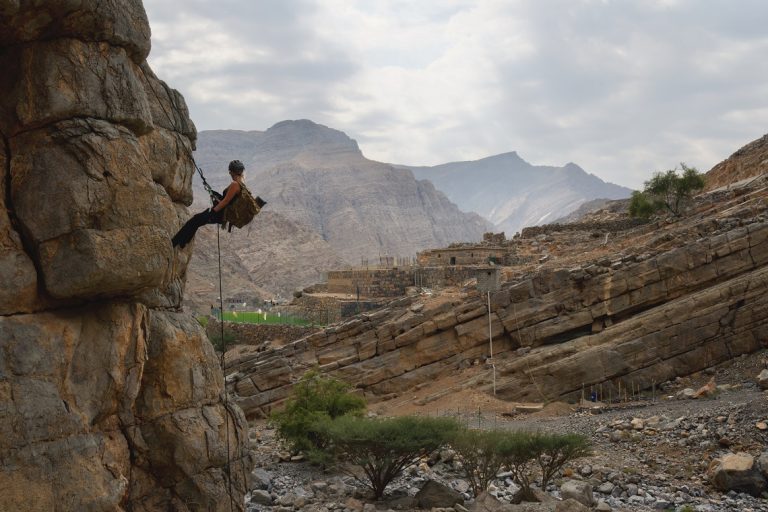BEAR GRYLLS: 24-HOUR SURVIVAL
According to ex-SAS man BEAR GRYLLS, it’s possible to SURVIVE for three months without HUMAN CONTACT; three weeks without FOOD; three days without WATER, and three minutes without AIR. MAXWELL ROCHE is about to find out if he has what it takes to last 24 hours in the WILD…
Alright, you ingrates, it’s 7 am. I want you standing to attention outside your digs in two minutes!”. Muted panic echoes through the canyon as people scramble from their cosy cocoons and unzip tent flaps to the sandy beyond.“Hear me, people. I do not discriminate,” bellows Jake, ‘the authority’. If my own mother was in basic training, I’d give her a beasting, too. Twenty burpees all of you, now!”.
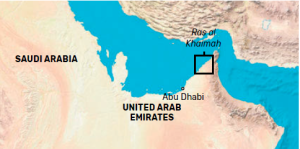 We kiss the dust like dominos, amused by the unexpected roleplay. Yawns become heavy breathing. “Right, now, duck race! Squat down, quads on calves and run in that position. First one round the tree and back is the least pathetic. Go, go, go!”.
We kiss the dust like dominos, amused by the unexpected roleplay. Yawns become heavy breathing. “Right, now, duck race! Squat down, quads on calves and run in that position. First one round the tree and back is the least pathetic. Go, go, go!”.
Amusement turns to agony. Duck running is the most excruciating exercise in the known universe. “Ok everybody, stop, stop, well done” says our instructor Jake, grinning. Relief resounds. “That was just a little simulation courtesy of Bear and his friends at 21 SAS Regiment. Once in a while, he likes us to motivate our clients military-style”.
BEAR WITH ME
So, how did I come to be quads on fire, sand in every orifice, squatting for my life at the bottom of a canyon in the Middle East? Well, once upon a time there was a boy named Edward ‘Bear’ Michael Grylls. He was a scout who became a marine, a marine who became an SAS operative, and an SAS operative who became a household name. Despite a near-fatal parachute injury in 1996, one year later he became the youngest man to climb Mount Everest. After that, the rest was easy. He tore through life biting the heads off live snakes, straining camel poo and drinking it through his socks, and abseiling into random lakes. He even earned an OBE for his loveable tough-nut antics. Who better, then, to train my pasty behind in the ways of the wild?
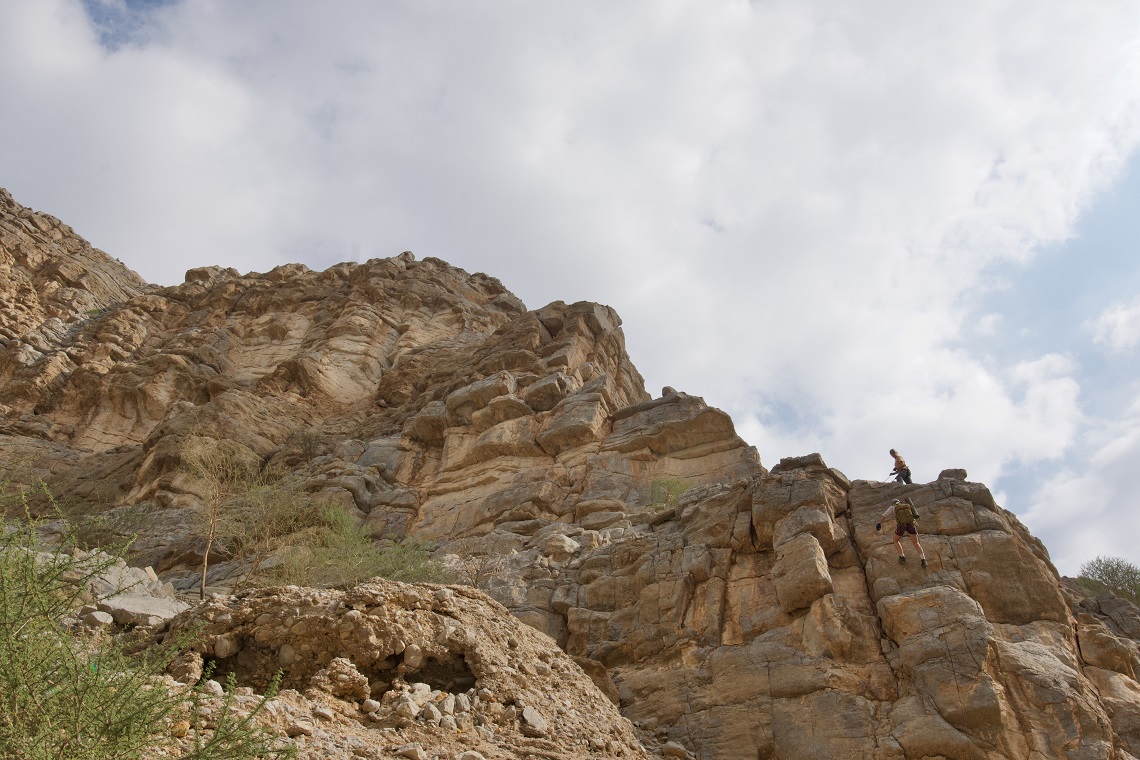
Given the last 12 months of global weirdness, a crash course in survivalism didn’t seem like such a bad idea. If you want to learn from the Bear (well, not the great man himself, but a group of experts who teach according to his methods) you have to pay a visit to Bear’s House. Ras Al Khaimah is the northernmost emirate of the United Arab Emirates. Little talked about and lightyears away topographically from the glitz of Dubai, it comprises a desolate peninsula.
Hemmed by the Omani and Persian Gulfs, so called ‘RAK’ plays host to multiple ecosystems from deserts to salt flats, mountains to mangroves. Dissecting the peninsula is the mountain spine of Jebel Jais. Seismic valleys frame desolate, forbidding and largely uninhabited (save for a few hardcore goats) mountains of nearly 2,000m. These mountains, owing to their pristine hostility, caught the Bear’s attention. Cue Bear Grylls Explorer Camp, Jebel Jais.
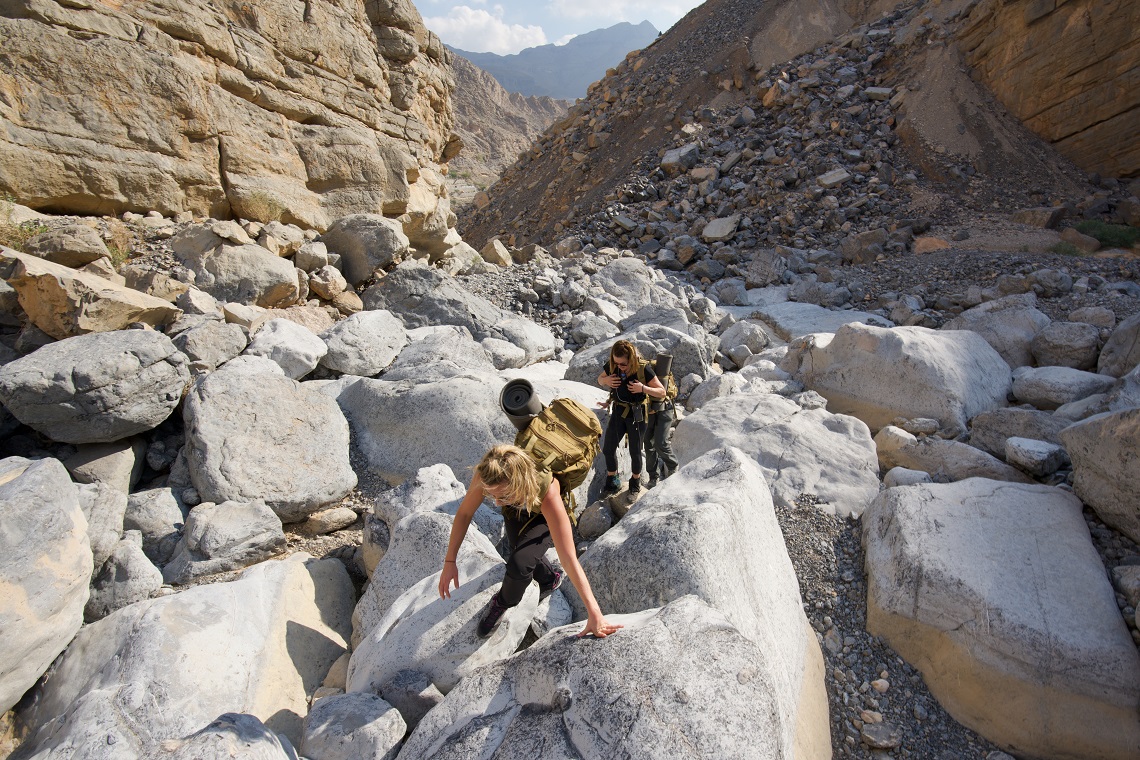
Upon arrival, a group orientation session is led by our instructors (Bear’s disciples) Tom, Jake, and Jude. Our equipment is laid out on a tarpaulin and we are instructed on how best to pack and order our backpacks ie, don’t bury your bananas below your sleeping bag. In between dad jokes and playful banter, the instructors take turns to introduce themselves, each listing with humility their extensive outdoor credentials; the overarching sentiment being that passion for the wild, and a belief in the endeavour, runs deep across the board. “This isn’t a playground after all,” says Jake. “We’re here to respect and better understand mother nature”. Sounds ominous. To shatter the lingering disquiet Tom skips across the carpark and yells “Follow me!”.
The journey begins at the base of a wadi (Arabic for river valley). A setting full of drama, the striated walls of the wadi streak upwards like the twitching muscles on a sprinter’s calf. Jude tells us that the base of the wadi, although currently bone dry, can quickly be engulfed by biblical volumes of raging water. As we clamber slowly up the steepening riverbed, which is full of cascading, house-sized boulders, Jude teaches us to assist each other over the obstacles using a Roman-style handshake (taking hold of each other’s wrists). Seems to work. Some Bear magic locked in already.
FIRE STARTER
Our first formal survival lesson takes place in the shade of a large Acacia tree. Using the length of rope we’ve each got stashed in our rucksacks, Tom, a self-confessed ‘Master of Knots’, teaches us a number of vital and ingenious rope tricks. Seemingly, then, it’s not ‘how long is a piece of string’ that counts, it’s what you do with it. Each knot lends itself to a particular problem-solving application, be it an everyday domestic task or as Jude puts it in her soft Edinburgh accent, “A wee matter of life and death”. Holding my alpine butterfly aloft, deemed masterful by my peers, I’m already imagining ways to crowbar it into my daily life.
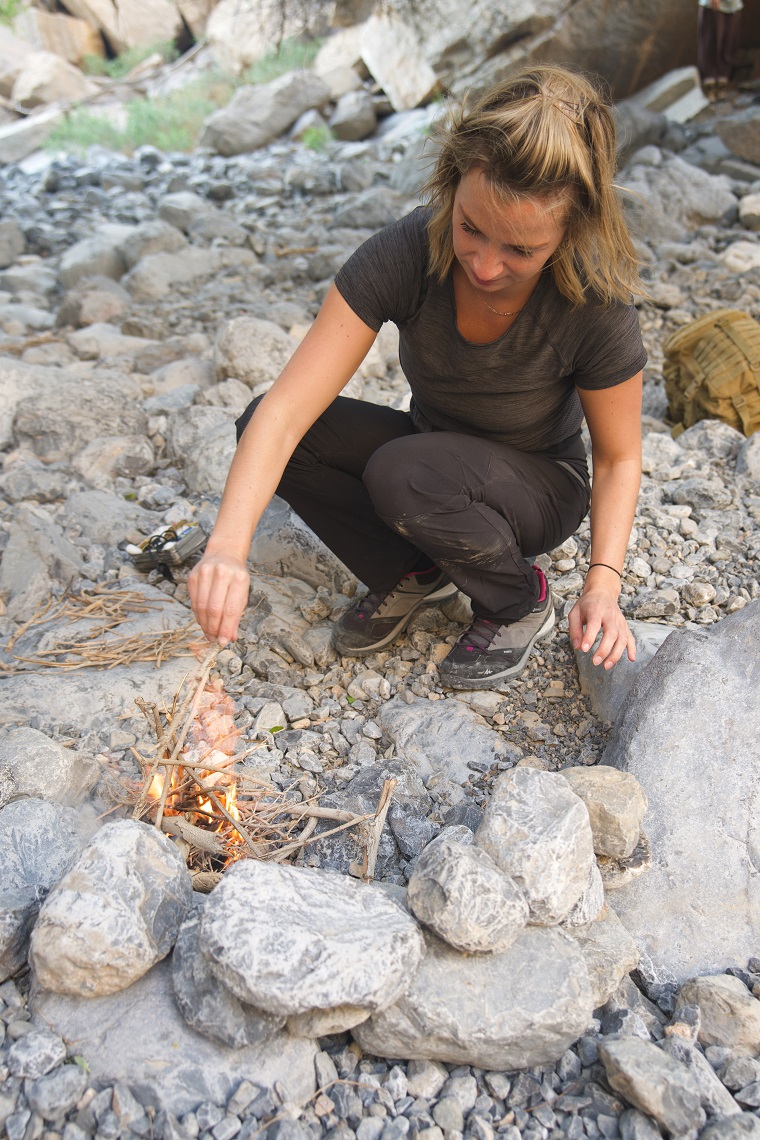
“Fire,” Jake tells us with a smile,“is nature’s TV.’” – a quote he attributes to Bear himself. We sit transfixed by the opening scenes of flickering flame as he demonstrates a number of ways to make things burn. “What three things enable combustion?” Jake asks “Heat, oxygen, and fuel,” cries a smartarse from the back row. “Correct,” says Jake before showing us how, using a battery, a magnifying glass, flint, or just plain old-fashioned friction, precious sparks can be born. He recommends using a hard and fast 15/5 ratio when building fires in the wilderness; 15 minutes preparation for every five minutes of ignition.
With that, we fan out across the wadi in search of the next crucial ingredient, fuel. Gathering wood of varying sizes, we stack it carefully in separate piles before turning our attention to the framework. A lattice configuration, we learn, allows for better airflow, so we do away with the traditional pyramid. “Tinder,’’ says Jake, “is not a famous digital application for finding a sexual partner. It’s the final crucial ingredient on our incendiary journey.” Someone cracks a lewd gag about a naked old-flame and we continue.
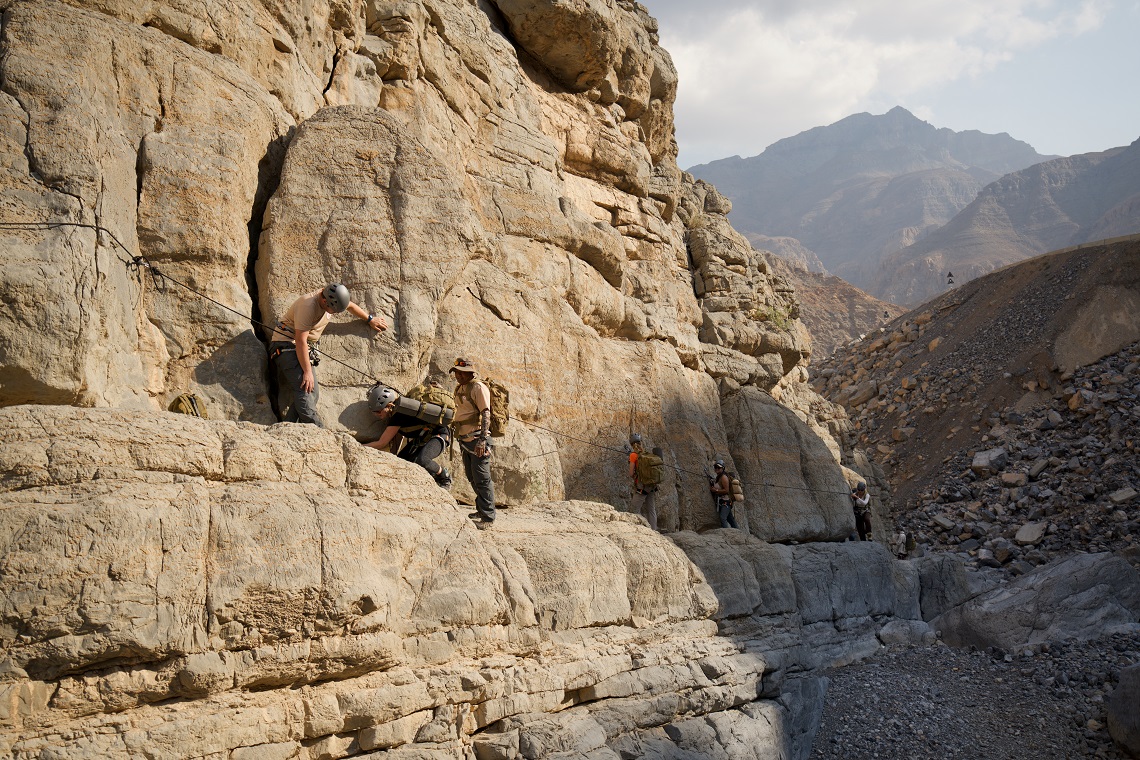
Resourceful survivalists can use anything from dry moss and lichen to jacket insulation to nurture their initial spark, we are told. Lesson over, we separate into teams with 20 minutes to make the magic happen. As the flames lick through our carefully laid lattice, a primal satisfaction overwhelms me. Resisting the urge to dance around in circles like old King Louis, I pay homage to the gods. I can now boil and sanitise water, cook, stay warm, and ward off wild animals. Thanks, Bear.
A BIRD IN THE HAND
Further up the wadi, or should I say cliff, since we’re now all wearing climbing harnesses and putting our newfound knot skills to the test, we traverse the vertical valley wall via a series of ropes. Jude coaxes us along the narrow ledges which end in a small chasm. Using a technique called the ‘tyrolean traverse’ we are shown how to shimmy belly first along a single horizontal rope to the other side. In the interest of balance, we’re instructed to let one leg dangle and hook the other over the rope behind us. Those that fall off are taught how to get back on using a pendulum swing action (harder than it looks). Friction builds around my crown jewels as I successfully negotiate the traverse and drop down to the group like Sylvester Stallone.
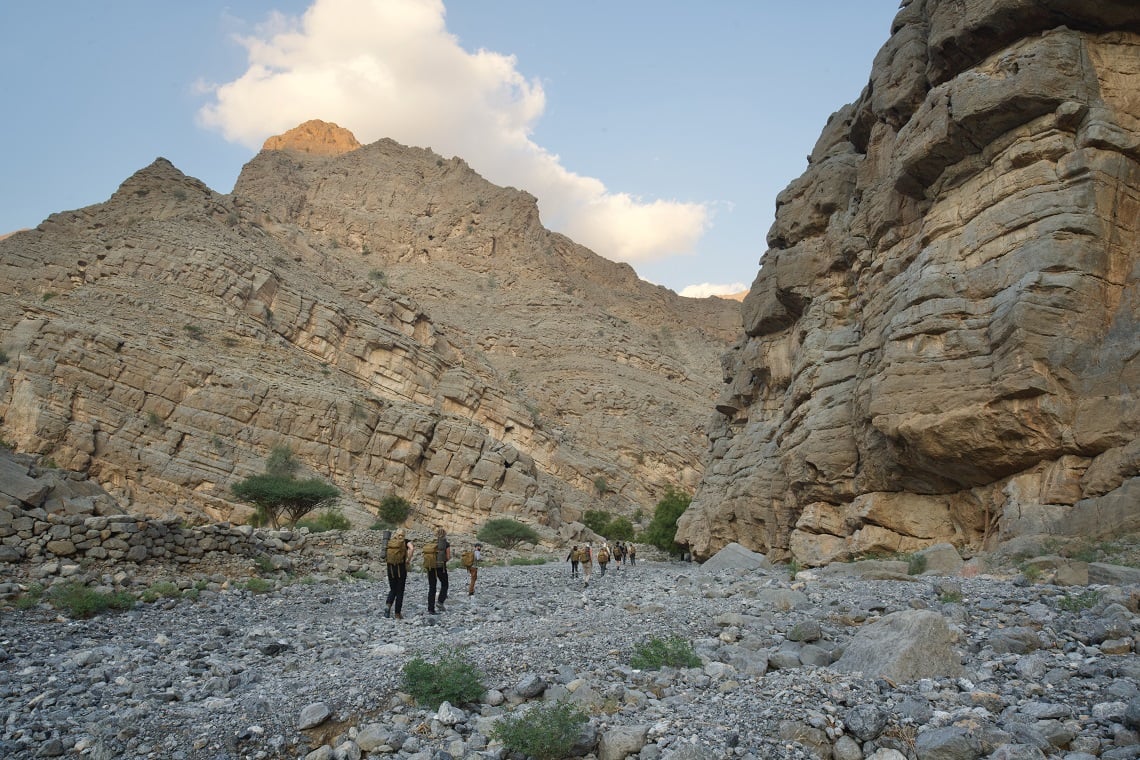
Continuing on the Stallone theme, Jake removes a huge Rambo-style knife from his backpack and kneels down for our next lesson. We stand at a distance, outside of what he calls his ‘blood bubble’. “This,” he says pointing to the femoral arteries that run along his inner thighs “Is the triangle of death”. “Never cut near, or towards this area unless you want to bleed to death in less than five minutes.” Gulp. He passes the knife to me, safely, palm and sharp edge up, handle first.
Soon, it’s time for a break, but unfortunately for us, this is Bear’s House, and they don’t do tea and biscuits. Instead, we are given a pile of worms. “A vital source of protein,” says Tom as he throws a few back like bar snacks, nodding his head approvingly. We each take a small assortment of arthropods and follow suit. Not bad, actually. Reminiscent of Bombay mix but with a distinct aftertaste of, well… worm, that lingers on the tonsils. Knowing how questionable some of Bear’s on-screen emergency food choices can be, this is a huge get out of jail free card, or so we thought…
As the sun’s golden shoulder slices down through the wadi, stomachs are beginning to rumble. Appetites whet by beetle lava moments earlier are now in need of more substantial satisfaction. We are assured that with the right trapping techniques, a satisfying meaty dinner isn’t far away. “Animals,” says Tom, “like water, tend to choose the path of least resistance.”
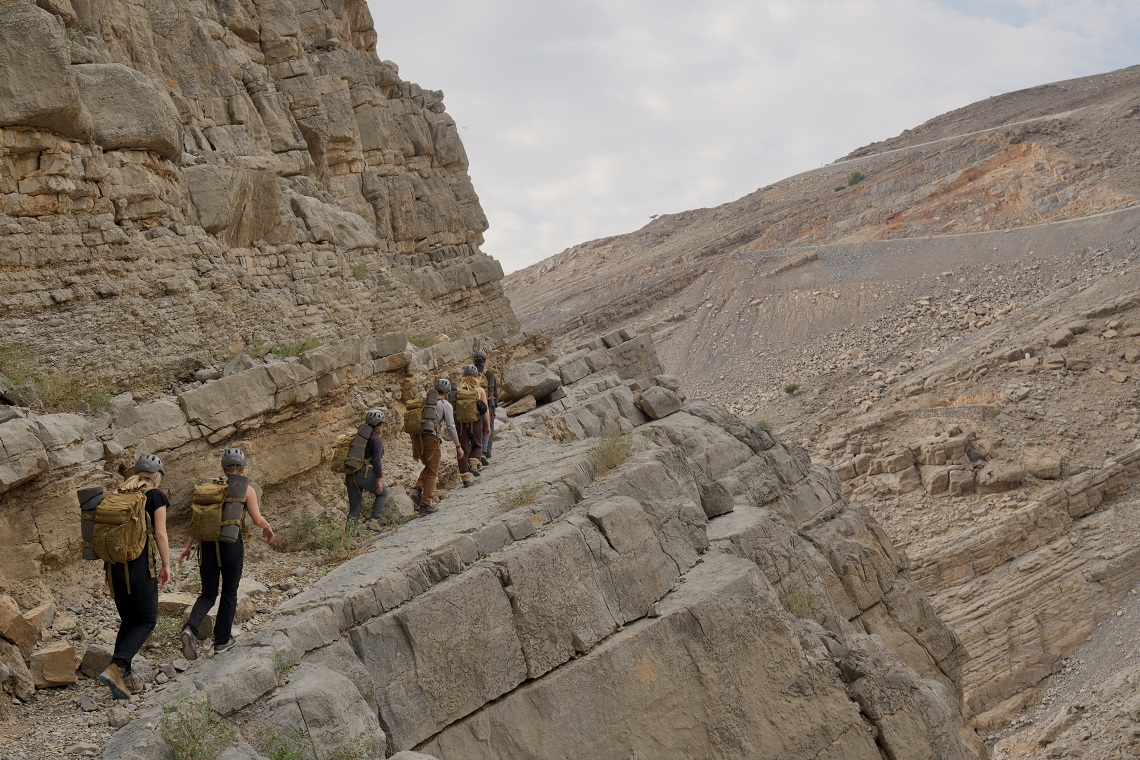
We nod intrigued. “So, to guide them into our trap, we need to create a barrier, cover our scent, position some bate, and boom!” We each take turns to lay traps using rocks, twigs, and shoelaces. Next comes the Blue Peter moment. Since we don’t have time to wait for unsuspecting prey before making camp, Tom whips a surprise out of his backpack. “Here’s one I made earlier,” he says ceremoniously handing us each a dead pigeon. Now, I’m not the kind of guy who gags at the thought of eating a bruised banana, but the nostril-clogging aroma as we use our bare hands to butcher the pigeons is nauseating to say the least.
Tom teaches us how to detach the head and wings, then separate the ribcage to remove the heart, liver, and lungs until we are left with nothing but the breast meat. As we watch the meat smoulder on the BBQ, I think to myself how far removed I have become from my food and its gruesome origins. It’s a humbling experience. After dinner, we are treated to a short but hypnotic session on night navigation. We learn to find Polaris (the North Star) and the Southern Cross using various other constellations before pitching our tents — fly sheets only, and drifting off below a starry ceiling.
THE FINAL TEST
The next morning, after the now-anticipated SAS style workout, Jude teaches us daytime navigation. We find south by triangulating the sun on a watch face and analysing shadows that fall between carefully positioned sticks. While waiting for navigational shadows to move we also learn to build environment appropriate shelters, find, filter and purify water via ingenious methods such as condensation and signal for rescue using smoke… the list just goes on.
Now it’s time to put everything we’ve learned to the test. Cue another roleplay. We’ve crash-landed in Ras Al Khaimah; we need to build a shelter, find water, catch food, start a fire, chart a course for higher ground and signal for rescue. We split into teams and engage survival mode, scrambling methodically and channelling our inner Bear. Success is assured but the would-be rescuers are waving from the opposite side of the valley. Nothing for it. Over the precipice, we go by means of a sheer 40m abseil complete with gnarly overhang.
Attending a Bear Grylls 24-hour survival course isn’t so much a FOMO (fear of missing out) experience as it is a FODO (fear of dying out) necessity. Fascinating practical skills are taught, and invaluable insights are gleaned from consummate professionals in truly beauteous surroundings. So, ahead of any potentially cataclysmic events, experienced adventurers and detached city-dwellers alike would be wise to seek out the one they call Bear; because if you go down to the woods today, you’re sure of a big surprise.
The 24-hour experience costs £250 with a less expensive 4-hour option available for those who simply wish to dip the toe.
Courses can be booked at beargryllscamp.ae
@beargryllscamp
@visitrasalkhaimah
@visitjebeljais
WHO’S WRITING?
 Maxwell Roche is a journalist/incongruous caveman who spends much of his time in antiquarian bookshops taking great-long-sniffs.
Maxwell Roche is a journalist/incongruous caveman who spends much of his time in antiquarian bookshops taking great-long-sniffs.
He also hurls himself off, down or into anything for a story or a photograph, travelling in search of a view, because it’s all about the view. He’s a desperate skydiver, addicted surfer and frivolous cyclist, horrified by the prospect of missing out and tormented by indecision regarding his future.



